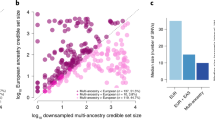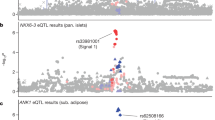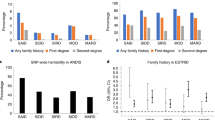Abstract
Candidate gene studies have long been the principal method for identification of susceptibility genes for type I diabetes (T1D), resulting in the discovery of HLA, INS, PTPN22, CTLA4, and IL2RA. However, many of the initial studies that relied on this strategy were largely underpowered, because of the limitations in genomic information and genotyping technology, as well as the limited size of available cohorts. The Type I Diabetes Genetic Consortium (T1DGC) has established resources to re-evaluate earlier reported genes associated with T1D, using its collection of 2298 Caucasian affected sib-pair families (with 11 159 individuals). A total of 382 single-nucleotide polymorphisms (SNPs) located in 21 T1D candidate genes were selected for this study and genotyped in duplicate on two platforms, Illumina and Sequenom. The genes were chosen based on published literature as having been either ‘confirmed’ (replicated) or not (candidates). This study showed several important features of genetic association studies. First, it showed the major impact of small rates of genotyping errors on association statistics. Second, it confirmed associations at INS, PTPN22, IL2RA, IFIH1 (earlier confirmed genes), and CTLA4 (earlier confirmed, with distinct SNPs) loci. Third, it did not find evidence for an association with T1D at SUMO4, despite confirmed association in Asian populations, suggesting the potential for population-specific gene effects. Fourth, at PTPN22, there was evidence for a novel contribution to T1D risk, independent of the replicated effect of the R620W variant. Fifth, among the candidate genes selected for replication, the association of TCF7-P19T with T1D was newly replicated in this study. In summary, this study was able to replicate some genetic effects, reject others, and provide suggestions of association with several of the other candidate genes in stratified analyses (age at onset, HLA status, population of origin). These results have generated additional interesting functional hypotheses that will require further replication in independent cohorts.
This is a preview of subscription content, access via your institution
Access options
Subscribe to this journal
Receive 6 digital issues and online access to articles
$119.00 per year
only $19.83 per issue
Buy this article
- Purchase on Springer Link
- Instant access to full article PDF
Prices may be subject to local taxes which are calculated during checkout
Similar content being viewed by others
References
Smyth DJ, Cooper JD, Bailey R, Field S, Burren O, Smink LJ et al. A genome-wide association study of nonsynonymous SNPs identifies a type 1 diabetes locus in the interferon-induced helicase (IFIH1) region. Nat Genet 2006; 38: 617–619.
Rich SS, Akolkar B, Concannon P, Erlich H, Hilner JE, Julier C et al. Over view of the Type I Diabetes Genetics Consortium. Genes Immun 2009; 10 (Suppl 1): S1–S4.
Ikegami H, Kawabata Y, Noso S, Fujisawa T, Ogihara T . Genetics of type 1 diabetes in Asian and Caucasian populations. Diabetes Res Clin Pract 2007; 77 (Suppl 1): S116–S121.
Brown WM, Pierce JJ, Hilner JE, Perdue LH, Lohman K, Lu L et al. and the Type I Diabetes Genetics Consortium. Overview of the Rapid Response data. Genes Immun 2009; 10 (Suppl 1): S5–S15.
Bell GI, Horita S, Karam JH . A polymorphic locus near the human insulin gene is associated with insulin-dependent diabetes mellitus. Diabetes 1984; 33: 176–183.
Julier C, Lucassen A, Villedieu P, Delepine M, Levy Marchal C, Danze PM et al. Multiple DNA variant association analysis: application to the insulin gene region in type I diabetes. Am J Hum Genet 1994; 55: 1247–1254.
Barratt BJ, Payne F, Lowe CE, Hermann R, Healy BC, Harold D et al. Remapping the insulin gene/IDDM2 locus in type 1 diabetes. Diabetes 2004; 53: 1884–1889.
Bennett ST, Lucassen AM, Gough SC, Powell EE, Undlien DE, Pritchard LE et al. Susceptibility to human type 1 diabetes at IDDM2 is determined by tandem repeat variation at the insulin gene minisatellite locus. Nat Genet 1995; 9: 284–292.
Bottini N, Musumeci L, Alonso A, Rahmouni S, Nika K, Rostamkhani M et al. A functional variant of lymphoid tyrosine phosphatase is associated with type I diabetes. Nat Genet 2004; 36: 337–338.
Baniasadi V, Das SN . No evidence for association of PTPN22 R620W functional variant C1858T with type 1 diabetes in Asian Indians. J Cell Mol Med 2008; 12: 1061–1062.
Kawasaki E, Awata T, Ikegami H, Kobayashi T, Maruyama T, Nakanishi K et al. Systematic search for single nucleotide polymorphisms in a lymphoid tyrosine phosphatase gene (PTPN22): association between a promoter polymorphism and type 1 diabetes in Asian populations. Am J Med Genet 2006; 140A: 586–593.
Nistico L, Buzzetti R, Pritchard LE, Van der Auwera B, Giovannini C, Bosi E et al. The CTLA-4 gene region of chromsome 2q33 is linked to, and associated with, type I diabetes. Hum Mol Genet 1996; 5: 1075–1080.
Marron MP, Raffel LJ, Garchon HJ, Jacob CO, Serrano-Rios M, Martinez Larrad MT et al. Insulin-dependent diabetes mellitus (IDDM) is associated with CTLA4 polymorphisms in multiple ethnic groups. Hum Mol Genet 1997; 6: 1275–1282.
Ueda H, Howson JM, Esposito L, Heward J, Snook H, Chamberlain G et al. Association of the T-cell regulatory gene CTLA4 with susceptibility to autoimmune disease. Nature 2003; 423: 506–511.
Concannon P, Erlich HA, Julier C, Morahan G, Nerup J, Pociot F et al. Type 1 diabetes: evidence for susceptibility loci from four genome-wide linkage scans in 1,435 multiplex families. Diabetes 2005; 54: 2995–3001.
Vella A, Cooper JD, Lowe CE, Walker N, Nutland S, Widmer B et al. Localization of a type 1 diabetes locus in the IL2RA/CD25 region by use of tag single-nucleotide polymorphisms. Am J Hum Genet 2005; 76: 773–779.
Qu HQ, Montpetit A, Ge B, Hudson TJ, Polychronakos C . Toward further mapping of the association between the IL2RA locus and type 1 diabetes. Diabetes 2007; 56: 1174–1176.
Lowe CE, Cooper JD, Brusko T, Walker NM, Smyth DJ, Bailey R et al. Large-scale genetic fine mapping and genotype-phenotype associations implicate polymorphism in the IL2RA region in type 1 diabetes. Nat Genet 2007; 39: 1074–1082.
Guo D, Li M, Zhang Y, Yang P, Eckenrode S, Hopkins D et al. A functional variant of SUMO4, a new I kappa B alpha modifier, is associated with type 1 diabetes. Nat Genet 2004; 36: 837–841.
Park Y, Park S, Kang J, Yang S, Kim D . Assessing the validity of the association between the SUMO4 M55V variant and risk of type 1 diabetes. Nat Genet 2005; 37: 112; author reply 112–113.
Noso S, Ikegami H, Fujisawa T, Kawabata Y, Asano K, Hiromine Y et al. Genetic heterogeneity in association of the SUMO4 M55V variant with susceptibility to type 1 diabetes. Diabetes 2005; 54: 3582–3586.
Morahan G, Huang D, Ymer SI, Cancilla MR, Stephen K, Dabadghao P et al. Linkage disequilibrium of a type 1 diabetes susceptibility locus with a regulatory IL12B allele. Nat Genet 2001; 27: 218–221.
Field LL, Bonnevie-Nielsen V, Pociot F, Lu S, Nielsen TB, Beck-Nielsen H . OAS1 splice site polymorphism controlling antiviral enzyme activity influences susceptibility to type 1 diabetes. Diabetes 2005; 54: 1588–1591.
Pani MA, Knapp M, Donner H, Braun J, Baur MP, Usadel KH et al. Vitamin D receptor allele combinations influence genetic susceptibility to type 1 diabetes in Germans. Diabetes 2000; 49: 504–507.
Ramos-Lopez E, Jansen T, Ivaskevicius V, Kahles H, Klepzig C, Oldenburg J et al. Protection from type 1 diabetes by vitamin D receptor haplotypes. Ann N Y Acad Sci 2006; 1079: 327–334.
Dubois-Laforgue D, Hendel H, Caillat-Zucman S, Zagury JF, Winkler C, Boitard C et al. A common stromal cell-derived factor-1 chemokine gene variant is associated with the early onset of type 1 diabetes. Diabetes 2001; 50: 1211–1213.
Biason-Lauber A, Boehm B, Lang-Muritano M, Gauthier BR, Brun T, Wollheim CB et al. Association of childhood type 1 diabetes mellitus with a variant of PAX4: possible link to beta cell regenerative capacity. Diabetologia 2005; 48: 900–905.
Morrison VA, Onengut-Gumuscu S, Concannon P . A functional variant of IRS1 is associated with type 1 diabetes in families from the US and UK. Mol Genet Metab 2004; 81: 291–294.
Noble JA, White AM, Lazzeroni LC, Valdes AM, Mirel DB, Reynolds R et al. A polymorphism in the TCF7 gene, C883A, is associated with type 1 diabetes. Diabetes 2003; 52: 1579–1582.
Bassuny WM, Ihara K, Sasaki Y, Kuromaru R, Kohno H, Matsuura N et al. A functional polymorphism in the promoter/enhancer region of the FOXP3/Scurfin gene associated with type 1 diabetes. Immunogenet 2003; 55: 149–156.
Mirel DB, Valdes AM, Lazzeroni LC, Reynolds RL, Erlich HA, Noble JA . Association of IL4R haplotypes with type 1 diabetes. Diabetes 2002; 51: 3336–3341.
Bugawan TL, Mirel DB, Valdes AM, Panelo A, Pozzilli P, Erlich HA . Association and interaction of the IL4R, IL4, and IL13 loci with type 1 diabetes among Filipinos. Am J Hum Genet 2003; 72: 1505–1514.
Howson JMM, Walker NM, Smyth DJ, Todd JA and the Type I Diabetes Genetics Consortium. Analysis of 19 genes for association with type I diabetes in the Type I Diabetes Genetics Consortium families. Genes Immun 2009; 10 (Suppl 1): S74–S84.
Steck AK, Baschal EE, Jasinski JM, Boehm BO, Bottini N, Concannon P et al. and the Type I Diabetes Genetics Consortium. the Type I Diabetes Genetics Consortium. rs2476601 T allele (R620W) defines high-risk PTPN22 type I diabetes-associated haplotypes with preliminary evidence for an additional protective haplotype. Genes Immun 2009; 10 (Suppl 1): S21–S26.
Qu H-Q, Bradfield JP, Bélisle A, Grant SFA, Hakonarson H, Polychronakos C and the Type I Diabetes Genetics Consortium. The type I diabetes association of the IL2RA locus. Genes Immun 2009; 10 (Suppl 1): S42–S48.
Qu H-Q, Bradfield JP, Grant SFA, Hakonarson H, Polychronakos C and the Type I Diabetes Genetics Consortium. Remapping the type I diabetes association of the CTLA4 locus. Genes Immun 2009; 10 (Suppl 1): S27–S32.
Podolsky R, Prasad Linga-Reddy MV, She J-X and the Type I Diabetes Genetics Consortium. Analyses of multiple single-nucleotide polymorphisms in the SUMO4/IDDM5 region in affected sib-pair families with type I diabetes. Genes Immun 2009; 10 (Suppl 1): S16–S20.
Erlich HA, Valdes AM, Julier C, Mirel D, Noble JA and the Type I Diabetes Genetics Consortium. Evidence for association of the TCF7 locus with type I diabetes. Genes Immun 2009; 10 (Suppl 1): S54–S59.
Morahan G, McKinnon E, Berry J, Browning B, Julier C, Pociot F et al and the Type I Diabetes Genetics Consortium. Evaluation of IL12B as a candidate type I diabetes susceptibility gene using data from the Type I Diabetes Genetics Consortium. Genes Immun 2009; 10 (Suppl 1): S64–S68.
Qu H-Q, Polychronakos C and the Type I Diabetes Genetics Consortium. Reassessment of the type I diabetes association of the OAS1 locus. Genes Immun 2009; 10 (Suppl 1): S69–S73.
Kahles H, Morahan G, Todd JA, Badenhoop K and the Type I Diabetes Genetics Consortium. Association analyses of the vitamin D receptor gene in 1654 families with type I diabetes. Genes Immun 2009; 10 (Suppl 1): S60–S63.
Bergholdt R, Brorsson C, Boehm B, Morahan G, Pociot F and the Type I Diabetes Genetics Consortium. No association of the IRS1 and PAX4 genes with type I diabetes. Genes Immun 2009; 10 (Suppl 1): S49–S53.
Erlich HA, Lohman K, Mack SJ, Valdes AM, Julier C, Mirel D et al. for the Type I Diabetes Genetics Consortium. Association analysis of SNPs in the IL4R locus with type I diabetes. Genes Immun 2009; 10 (Suppl 1): S33–S41.
Todd JA, Walker NM, Cooper JD, Smyth DJ, Downes K, Plagnol V et al. Robust associations of four new chromosome regions from genome-wide analyses of type 1 diabetes. Nat Genet 2007; 39: 857–864.
Cooper JD, Smyth DJ, Smiles AM, Plagnol V, Walker NM, Allen JE et al. Meta-analysis of genome-wide association study data identifies additional type 1 diabetes risk loci. Nat Genet 2008; 40: 1399–1401.
Wellcome Trust Case Control Consortium. Genome-wide association study of 14 000 cases of seven common diseases and 3000 shared controls. Nature 2007; 447: 661–678.
Cooper JD, Walker NM, Healy BC, Smyth DJ, Downes K, Todd JA and the Type I Diabetes Genetics Consortium. Analysis of 55 autoimmune disease and type II diabetes loci: further confirmation of chromosomes 4q27, 12q13.2 and 12q24.13 as type I diabetes loci, and support for a new locus, 12q13.3–q14.1. Genes Immun 2009; 10 (Suppl 1): S95–S120.
Cooper JD, Walker NM, Smyth DJ, Downes K, Healy BC, Todd JA and the Type I Diabetes Genetics Consortium. Follow-up of 1715 SNPs from the Wellcome Trust Case Control Consortium genome-wide association study in type I diabetes families. Genes Immun 2009; 10 (Suppl 1): S85–S94.
Acknowledgements
This research uses resources provided by the Type I Diabetes Genetics Consortium, a collaborative clinical study sponsored by the National Institute of Diabetes and Digestive and Kidney Diseases (NIDDK), National Institute of Allergy and Infectious Diseases (NIAID), National Human Genome Research Institute (NHGRI), National Institute of Child Health and Human Development (NICHD), and Juvenile Diabetes Research Foundation International (JDRF) and supported by NIH grant U01 DK062418. We are grateful to all the T1D patients and family members who contributed samples and to all the participating T1DGC investigators and sites, listed at http://www.t1dgc.org. Genotyping was performed at the Broad Institute Center for Genotyping and Analysis is supported by grant U54 RR020278 from the National Center for Research Resources.
Author information
Authors and Affiliations
Consortia
Corresponding author
Rights and permissions
About this article
Cite this article
Julier, C., Akolkar, B., Concannon, P. et al. The Type I Diabetes Genetics Consortium ‘Rapid Response’ family-based candidate gene study: strategy, genes selection, and main outcome. Genes Immun 10 (Suppl 1), S121–S127 (2009). https://doi.org/10.1038/gene.2009.99
Published:
Issue Date:
DOI: https://doi.org/10.1038/gene.2009.99
Keywords
This article is cited by
-
The pancreas in human type 1 diabetes
Seminars in Immunopathology (2011)
-
Overview of the Type I Diabetes Genetics Consortium
Genes & Immunity (2009)
-
Overview of the Rapid Response data
Genes & Immunity (2009)



